HI6026 Audit Case Study: Double Ink Printers Ltd - Risk and Audit
VerifiedAdded on 2023/05/23
|10
|2543
|457
Case Study
AI Summary
This audit assignment focuses on Double Ink Printers Ltd (DIPL), performing analytical procedures to assess risks and plan the audit. It examines inherent risks, such as those related to a new IT system and revenue recognition practices, and identifies fraud risk factors, including inadequate segregation of duties and a questionable investment in Nuclear Publishing Ltd. The analysis emphasizes the importance of thorough audit procedures to detect material misstatements and potential fraud, referencing Australian auditing standards throughout. The study concludes that auditors must exercise due care and increase substantive procedures for transactions showing risk factors to ensure accurate financial reporting. Desklib provides access to similar solved assignments and past papers for students.
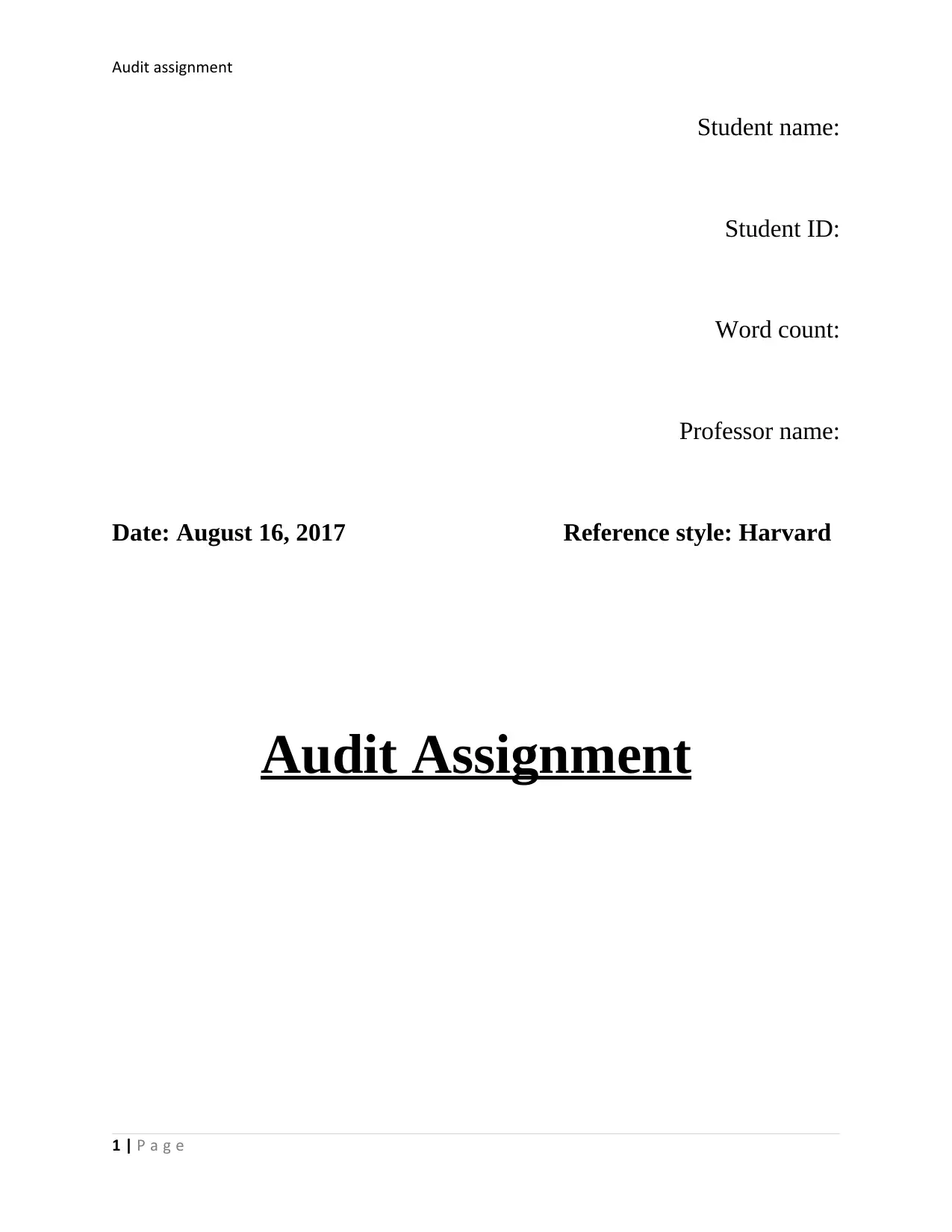
Audit assignment
Student name:
Student ID:
Word count:
Professor name:
Date: August 16, 2017 Reference style: Harvard
Audit Assignment
1 | P a g e
Student name:
Student ID:
Word count:
Professor name:
Date: August 16, 2017 Reference style: Harvard
Audit Assignment
1 | P a g e
Paraphrase This Document
Need a fresh take? Get an instant paraphrase of this document with our AI Paraphraser
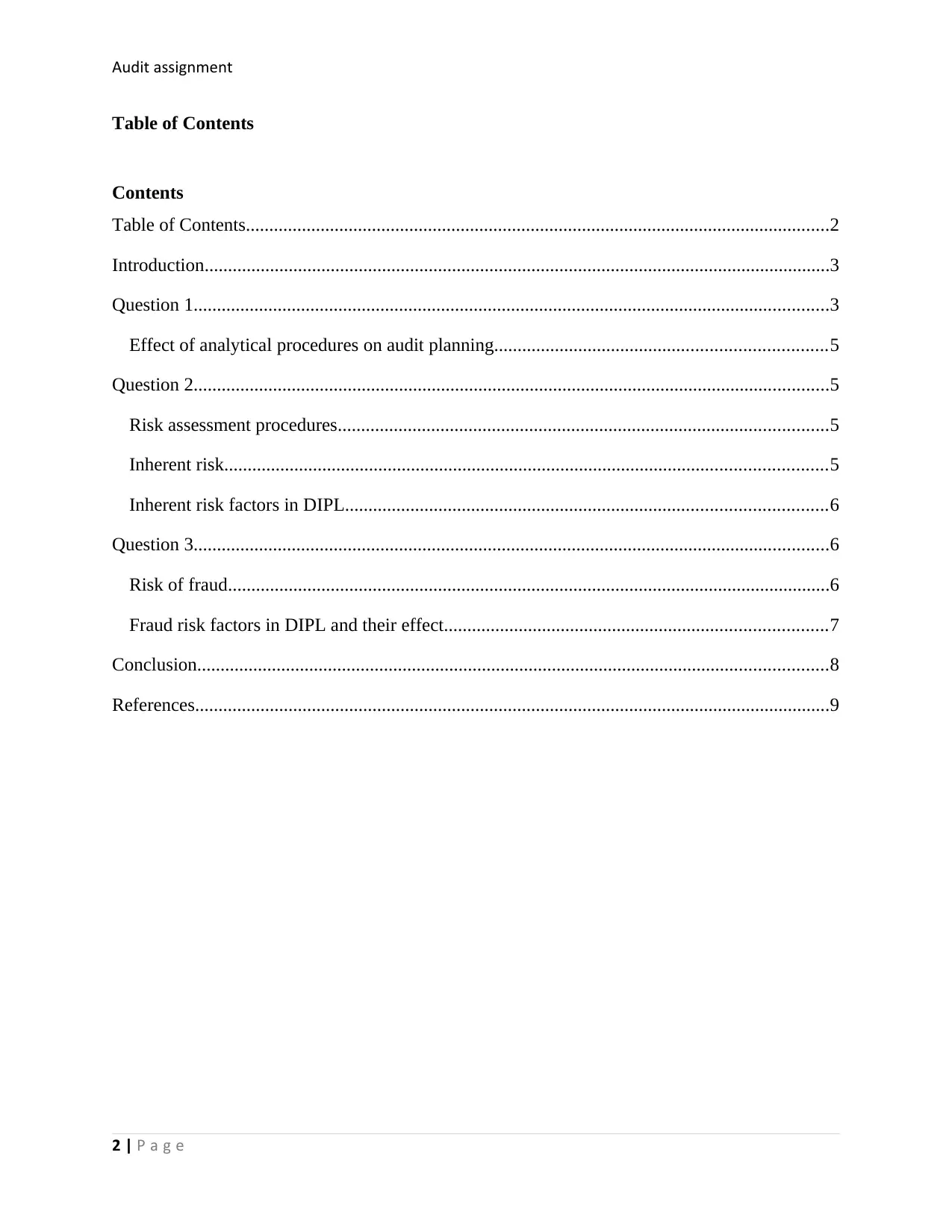
Audit assignment
Table of Contents
Contents
Table of Contents.............................................................................................................................2
Introduction......................................................................................................................................3
Question 1........................................................................................................................................3
Effect of analytical procedures on audit planning.......................................................................5
Question 2........................................................................................................................................5
Risk assessment procedures.........................................................................................................5
Inherent risk.................................................................................................................................5
Inherent risk factors in DIPL.......................................................................................................6
Question 3........................................................................................................................................6
Risk of fraud.................................................................................................................................6
Fraud risk factors in DIPL and their effect..................................................................................7
Conclusion.......................................................................................................................................8
References........................................................................................................................................9
2 | P a g e
Table of Contents
Contents
Table of Contents.............................................................................................................................2
Introduction......................................................................................................................................3
Question 1........................................................................................................................................3
Effect of analytical procedures on audit planning.......................................................................5
Question 2........................................................................................................................................5
Risk assessment procedures.........................................................................................................5
Inherent risk.................................................................................................................................5
Inherent risk factors in DIPL.......................................................................................................6
Question 3........................................................................................................................................6
Risk of fraud.................................................................................................................................6
Fraud risk factors in DIPL and their effect..................................................................................7
Conclusion.......................................................................................................................................8
References........................................................................................................................................9
2 | P a g e
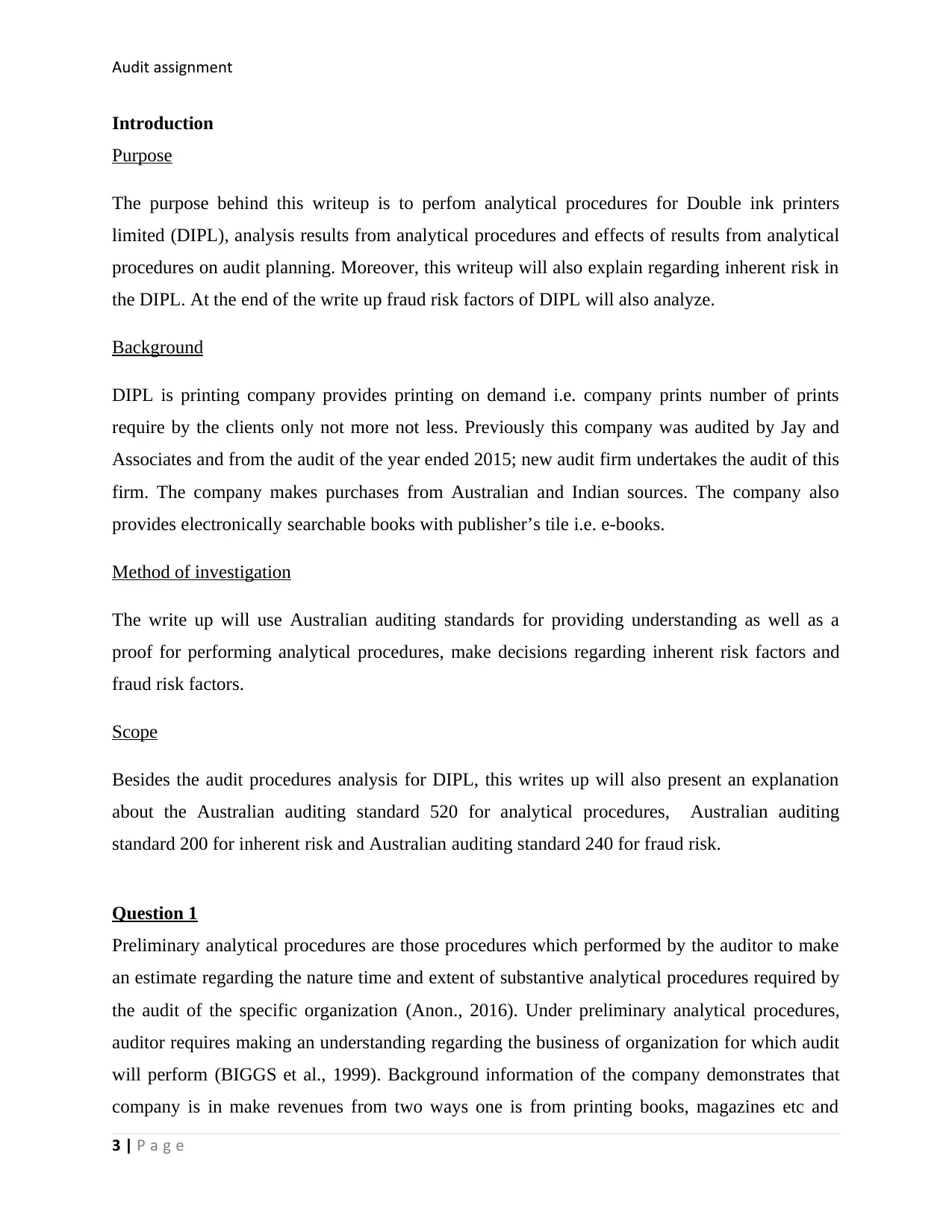
Audit assignment
Introduction
Purpose
The purpose behind this writeup is to perfom analytical procedures for Double ink printers
limited (DIPL), analysis results from analytical procedures and effects of results from analytical
procedures on audit planning. Moreover, this writeup will also explain regarding inherent risk in
the DIPL. At the end of the write up fraud risk factors of DIPL will also analyze.
Background
DIPL is printing company provides printing on demand i.e. company prints number of prints
require by the clients only not more not less. Previously this company was audited by Jay and
Associates and from the audit of the year ended 2015; new audit firm undertakes the audit of this
firm. The company makes purchases from Australian and Indian sources. The company also
provides electronically searchable books with publisher’s tile i.e. e-books.
Method of investigation
The write up will use Australian auditing standards for providing understanding as well as a
proof for performing analytical procedures, make decisions regarding inherent risk factors and
fraud risk factors.
Scope
Besides the audit procedures analysis for DIPL, this writes up will also present an explanation
about the Australian auditing standard 520 for analytical procedures, Australian auditing
standard 200 for inherent risk and Australian auditing standard 240 for fraud risk.
Question 1
Preliminary analytical procedures are those procedures which performed by the auditor to make
an estimate regarding the nature time and extent of substantive analytical procedures required by
the audit of the specific organization (Anon., 2016). Under preliminary analytical procedures,
auditor requires making an understanding regarding the business of organization for which audit
will perform (BIGGS et al., 1999). Background information of the company demonstrates that
company is in make revenues from two ways one is from printing books, magazines etc and
3 | P a g e
Introduction
Purpose
The purpose behind this writeup is to perfom analytical procedures for Double ink printers
limited (DIPL), analysis results from analytical procedures and effects of results from analytical
procedures on audit planning. Moreover, this writeup will also explain regarding inherent risk in
the DIPL. At the end of the write up fraud risk factors of DIPL will also analyze.
Background
DIPL is printing company provides printing on demand i.e. company prints number of prints
require by the clients only not more not less. Previously this company was audited by Jay and
Associates and from the audit of the year ended 2015; new audit firm undertakes the audit of this
firm. The company makes purchases from Australian and Indian sources. The company also
provides electronically searchable books with publisher’s tile i.e. e-books.
Method of investigation
The write up will use Australian auditing standards for providing understanding as well as a
proof for performing analytical procedures, make decisions regarding inherent risk factors and
fraud risk factors.
Scope
Besides the audit procedures analysis for DIPL, this writes up will also present an explanation
about the Australian auditing standard 520 for analytical procedures, Australian auditing
standard 200 for inherent risk and Australian auditing standard 240 for fraud risk.
Question 1
Preliminary analytical procedures are those procedures which performed by the auditor to make
an estimate regarding the nature time and extent of substantive analytical procedures required by
the audit of the specific organization (Anon., 2016). Under preliminary analytical procedures,
auditor requires making an understanding regarding the business of organization for which audit
will perform (BIGGS et al., 1999). Background information of the company demonstrates that
company is in make revenues from two ways one is from printing books, magazines etc and
3 | P a g e
⊘ This is a preview!⊘
Do you want full access?
Subscribe today to unlock all pages.

Trusted by 1+ million students worldwide
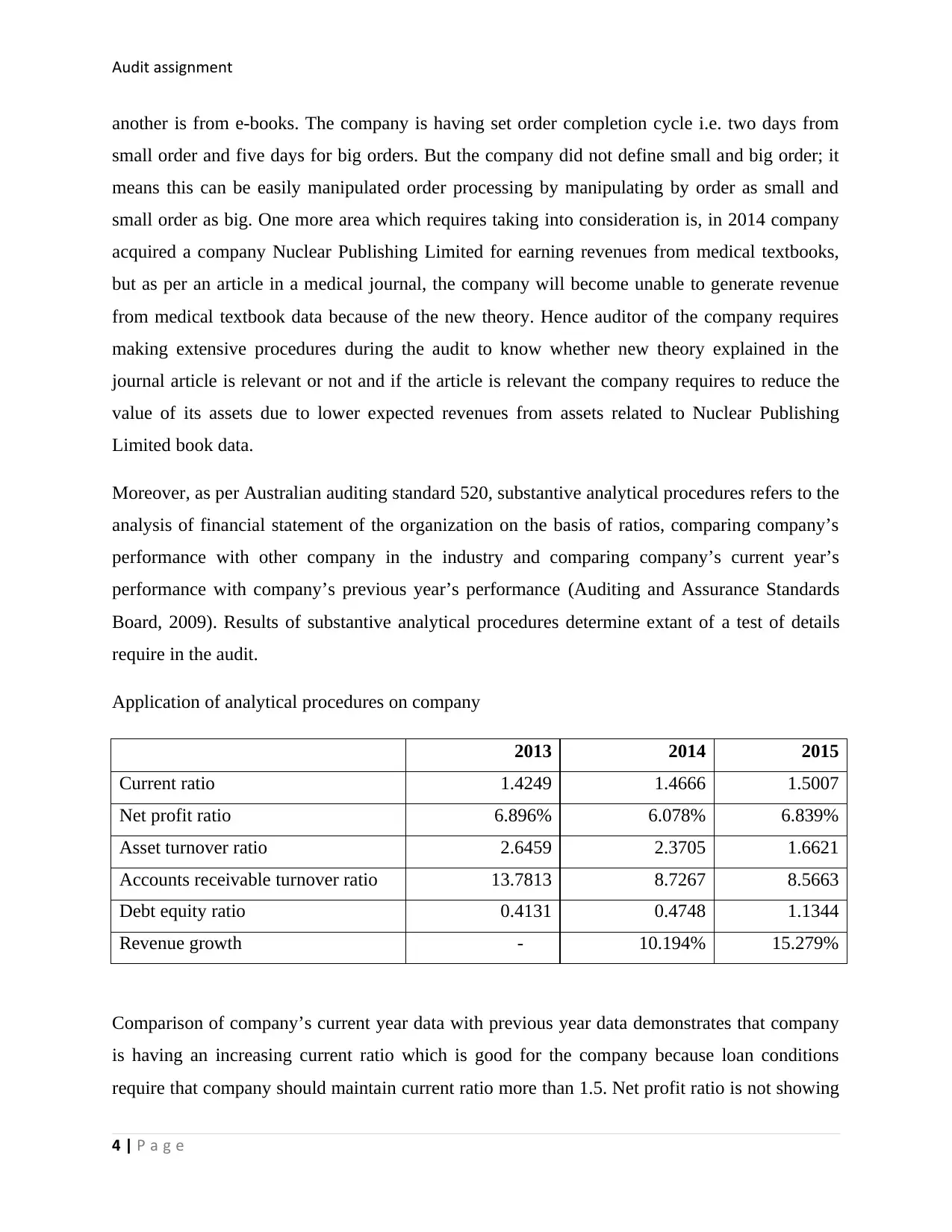
Audit assignment
another is from e-books. The company is having set order completion cycle i.e. two days from
small order and five days for big orders. But the company did not define small and big order; it
means this can be easily manipulated order processing by manipulating by order as small and
small order as big. One more area which requires taking into consideration is, in 2014 company
acquired a company Nuclear Publishing Limited for earning revenues from medical textbooks,
but as per an article in a medical journal, the company will become unable to generate revenue
from medical textbook data because of the new theory. Hence auditor of the company requires
making extensive procedures during the audit to know whether new theory explained in the
journal article is relevant or not and if the article is relevant the company requires to reduce the
value of its assets due to lower expected revenues from assets related to Nuclear Publishing
Limited book data.
Moreover, as per Australian auditing standard 520, substantive analytical procedures refers to the
analysis of financial statement of the organization on the basis of ratios, comparing company’s
performance with other company in the industry and comparing company’s current year’s
performance with company’s previous year’s performance (Auditing and Assurance Standards
Board, 2009). Results of substantive analytical procedures determine extant of a test of details
require in the audit.
Application of analytical procedures on company
2013 2014 2015
Current ratio 1.4249 1.4666 1.5007
Net profit ratio 6.896% 6.078% 6.839%
Asset turnover ratio 2.6459 2.3705 1.6621
Accounts receivable turnover ratio 13.7813 8.7267 8.5663
Debt equity ratio 0.4131 0.4748 1.1344
Revenue growth - 10.194% 15.279%
Comparison of company’s current year data with previous year data demonstrates that company
is having an increasing current ratio which is good for the company because loan conditions
require that company should maintain current ratio more than 1.5. Net profit ratio is not showing
4 | P a g e
another is from e-books. The company is having set order completion cycle i.e. two days from
small order and five days for big orders. But the company did not define small and big order; it
means this can be easily manipulated order processing by manipulating by order as small and
small order as big. One more area which requires taking into consideration is, in 2014 company
acquired a company Nuclear Publishing Limited for earning revenues from medical textbooks,
but as per an article in a medical journal, the company will become unable to generate revenue
from medical textbook data because of the new theory. Hence auditor of the company requires
making extensive procedures during the audit to know whether new theory explained in the
journal article is relevant or not and if the article is relevant the company requires to reduce the
value of its assets due to lower expected revenues from assets related to Nuclear Publishing
Limited book data.
Moreover, as per Australian auditing standard 520, substantive analytical procedures refers to the
analysis of financial statement of the organization on the basis of ratios, comparing company’s
performance with other company in the industry and comparing company’s current year’s
performance with company’s previous year’s performance (Auditing and Assurance Standards
Board, 2009). Results of substantive analytical procedures determine extant of a test of details
require in the audit.
Application of analytical procedures on company
2013 2014 2015
Current ratio 1.4249 1.4666 1.5007
Net profit ratio 6.896% 6.078% 6.839%
Asset turnover ratio 2.6459 2.3705 1.6621
Accounts receivable turnover ratio 13.7813 8.7267 8.5663
Debt equity ratio 0.4131 0.4748 1.1344
Revenue growth - 10.194% 15.279%
Comparison of company’s current year data with previous year data demonstrates that company
is having an increasing current ratio which is good for the company because loan conditions
require that company should maintain current ratio more than 1.5. Net profit ratio is not showing
4 | P a g e
Paraphrase This Document
Need a fresh take? Get an instant paraphrase of this document with our AI Paraphraser
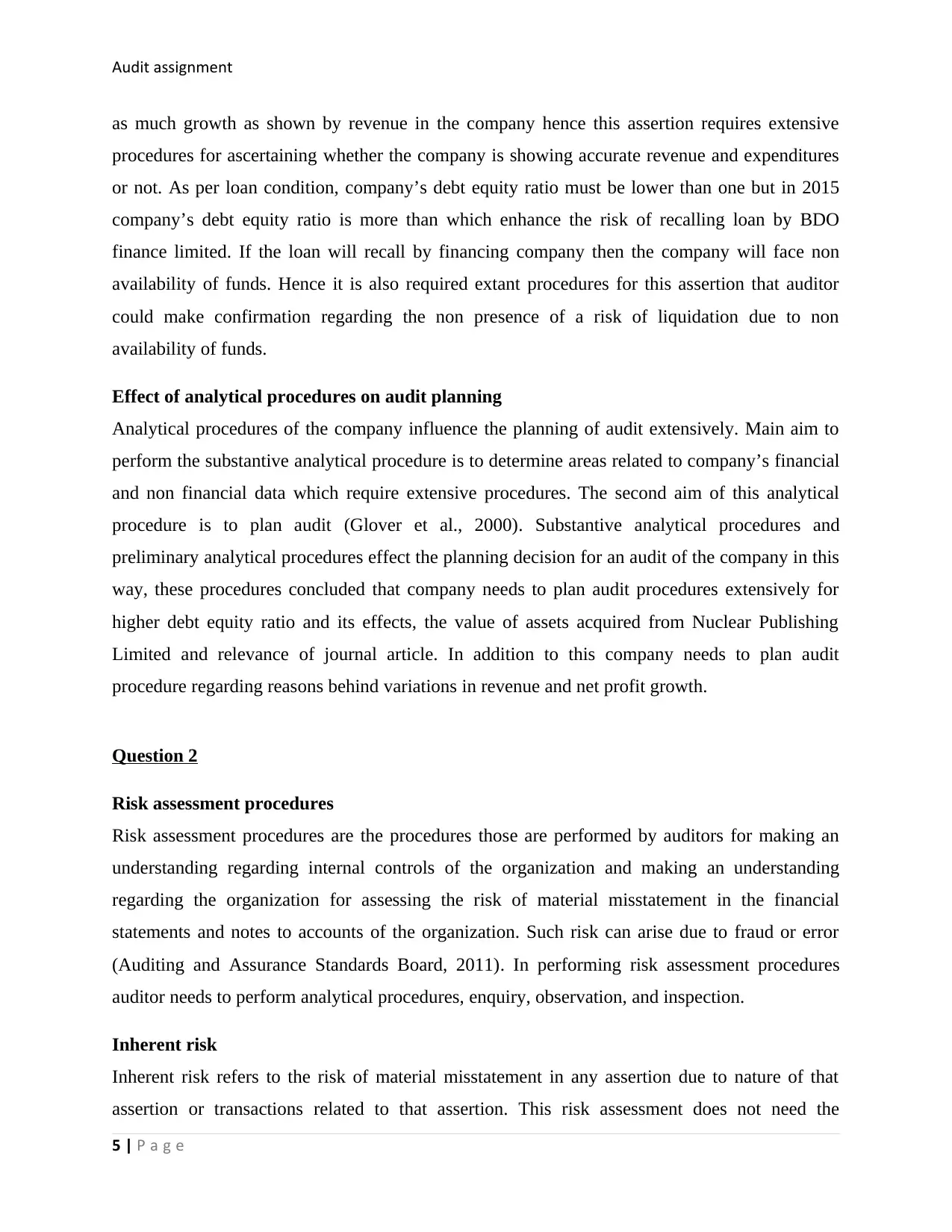
Audit assignment
as much growth as shown by revenue in the company hence this assertion requires extensive
procedures for ascertaining whether the company is showing accurate revenue and expenditures
or not. As per loan condition, company’s debt equity ratio must be lower than one but in 2015
company’s debt equity ratio is more than which enhance the risk of recalling loan by BDO
finance limited. If the loan will recall by financing company then the company will face non
availability of funds. Hence it is also required extant procedures for this assertion that auditor
could make confirmation regarding the non presence of a risk of liquidation due to non
availability of funds.
Effect of analytical procedures on audit planning
Analytical procedures of the company influence the planning of audit extensively. Main aim to
perform the substantive analytical procedure is to determine areas related to company’s financial
and non financial data which require extensive procedures. The second aim of this analytical
procedure is to plan audit (Glover et al., 2000). Substantive analytical procedures and
preliminary analytical procedures effect the planning decision for an audit of the company in this
way, these procedures concluded that company needs to plan audit procedures extensively for
higher debt equity ratio and its effects, the value of assets acquired from Nuclear Publishing
Limited and relevance of journal article. In addition to this company needs to plan audit
procedure regarding reasons behind variations in revenue and net profit growth.
Question 2
Risk assessment procedures
Risk assessment procedures are the procedures those are performed by auditors for making an
understanding regarding internal controls of the organization and making an understanding
regarding the organization for assessing the risk of material misstatement in the financial
statements and notes to accounts of the organization. Such risk can arise due to fraud or error
(Auditing and Assurance Standards Board, 2011). In performing risk assessment procedures
auditor needs to perform analytical procedures, enquiry, observation, and inspection.
Inherent risk
Inherent risk refers to the risk of material misstatement in any assertion due to nature of that
assertion or transactions related to that assertion. This risk assessment does not need the
5 | P a g e
as much growth as shown by revenue in the company hence this assertion requires extensive
procedures for ascertaining whether the company is showing accurate revenue and expenditures
or not. As per loan condition, company’s debt equity ratio must be lower than one but in 2015
company’s debt equity ratio is more than which enhance the risk of recalling loan by BDO
finance limited. If the loan will recall by financing company then the company will face non
availability of funds. Hence it is also required extant procedures for this assertion that auditor
could make confirmation regarding the non presence of a risk of liquidation due to non
availability of funds.
Effect of analytical procedures on audit planning
Analytical procedures of the company influence the planning of audit extensively. Main aim to
perform the substantive analytical procedure is to determine areas related to company’s financial
and non financial data which require extensive procedures. The second aim of this analytical
procedure is to plan audit (Glover et al., 2000). Substantive analytical procedures and
preliminary analytical procedures effect the planning decision for an audit of the company in this
way, these procedures concluded that company needs to plan audit procedures extensively for
higher debt equity ratio and its effects, the value of assets acquired from Nuclear Publishing
Limited and relevance of journal article. In addition to this company needs to plan audit
procedure regarding reasons behind variations in revenue and net profit growth.
Question 2
Risk assessment procedures
Risk assessment procedures are the procedures those are performed by auditors for making an
understanding regarding internal controls of the organization and making an understanding
regarding the organization for assessing the risk of material misstatement in the financial
statements and notes to accounts of the organization. Such risk can arise due to fraud or error
(Auditing and Assurance Standards Board, 2011). In performing risk assessment procedures
auditor needs to perform analytical procedures, enquiry, observation, and inspection.
Inherent risk
Inherent risk refers to the risk of material misstatement in any assertion due to nature of that
assertion or transactions related to that assertion. This risk assessment does not need the
5 | P a g e
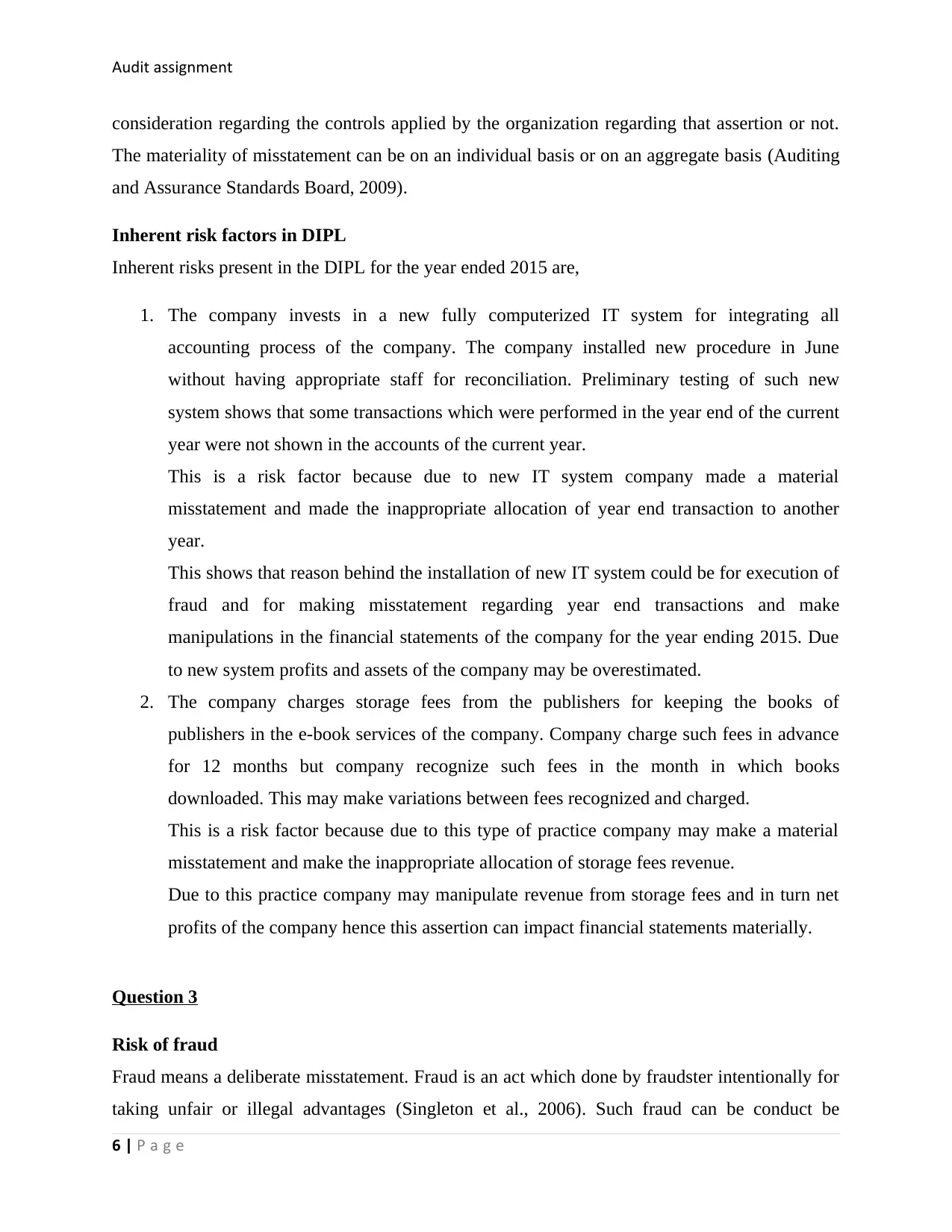
Audit assignment
consideration regarding the controls applied by the organization regarding that assertion or not.
The materiality of misstatement can be on an individual basis or on an aggregate basis (Auditing
and Assurance Standards Board, 2009).
Inherent risk factors in DIPL
Inherent risks present in the DIPL for the year ended 2015 are,
1. The company invests in a new fully computerized IT system for integrating all
accounting process of the company. The company installed new procedure in June
without having appropriate staff for reconciliation. Preliminary testing of such new
system shows that some transactions which were performed in the year end of the current
year were not shown in the accounts of the current year.
This is a risk factor because due to new IT system company made a material
misstatement and made the inappropriate allocation of year end transaction to another
year.
This shows that reason behind the installation of new IT system could be for execution of
fraud and for making misstatement regarding year end transactions and make
manipulations in the financial statements of the company for the year ending 2015. Due
to new system profits and assets of the company may be overestimated.
2. The company charges storage fees from the publishers for keeping the books of
publishers in the e-book services of the company. Company charge such fees in advance
for 12 months but company recognize such fees in the month in which books
downloaded. This may make variations between fees recognized and charged.
This is a risk factor because due to this type of practice company may make a material
misstatement and make the inappropriate allocation of storage fees revenue.
Due to this practice company may manipulate revenue from storage fees and in turn net
profits of the company hence this assertion can impact financial statements materially.
Question 3
Risk of fraud
Fraud means a deliberate misstatement. Fraud is an act which done by fraudster intentionally for
taking unfair or illegal advantages (Singleton et al., 2006). Such fraud can be conduct be
6 | P a g e
consideration regarding the controls applied by the organization regarding that assertion or not.
The materiality of misstatement can be on an individual basis or on an aggregate basis (Auditing
and Assurance Standards Board, 2009).
Inherent risk factors in DIPL
Inherent risks present in the DIPL for the year ended 2015 are,
1. The company invests in a new fully computerized IT system for integrating all
accounting process of the company. The company installed new procedure in June
without having appropriate staff for reconciliation. Preliminary testing of such new
system shows that some transactions which were performed in the year end of the current
year were not shown in the accounts of the current year.
This is a risk factor because due to new IT system company made a material
misstatement and made the inappropriate allocation of year end transaction to another
year.
This shows that reason behind the installation of new IT system could be for execution of
fraud and for making misstatement regarding year end transactions and make
manipulations in the financial statements of the company for the year ending 2015. Due
to new system profits and assets of the company may be overestimated.
2. The company charges storage fees from the publishers for keeping the books of
publishers in the e-book services of the company. Company charge such fees in advance
for 12 months but company recognize such fees in the month in which books
downloaded. This may make variations between fees recognized and charged.
This is a risk factor because due to this type of practice company may make a material
misstatement and make the inappropriate allocation of storage fees revenue.
Due to this practice company may manipulate revenue from storage fees and in turn net
profits of the company hence this assertion can impact financial statements materially.
Question 3
Risk of fraud
Fraud means a deliberate misstatement. Fraud is an act which done by fraudster intentionally for
taking unfair or illegal advantages (Singleton et al., 2006). Such fraud can be conduct be
6 | P a g e
⊘ This is a preview!⊘
Do you want full access?
Subscribe today to unlock all pages.

Trusted by 1+ million students worldwide
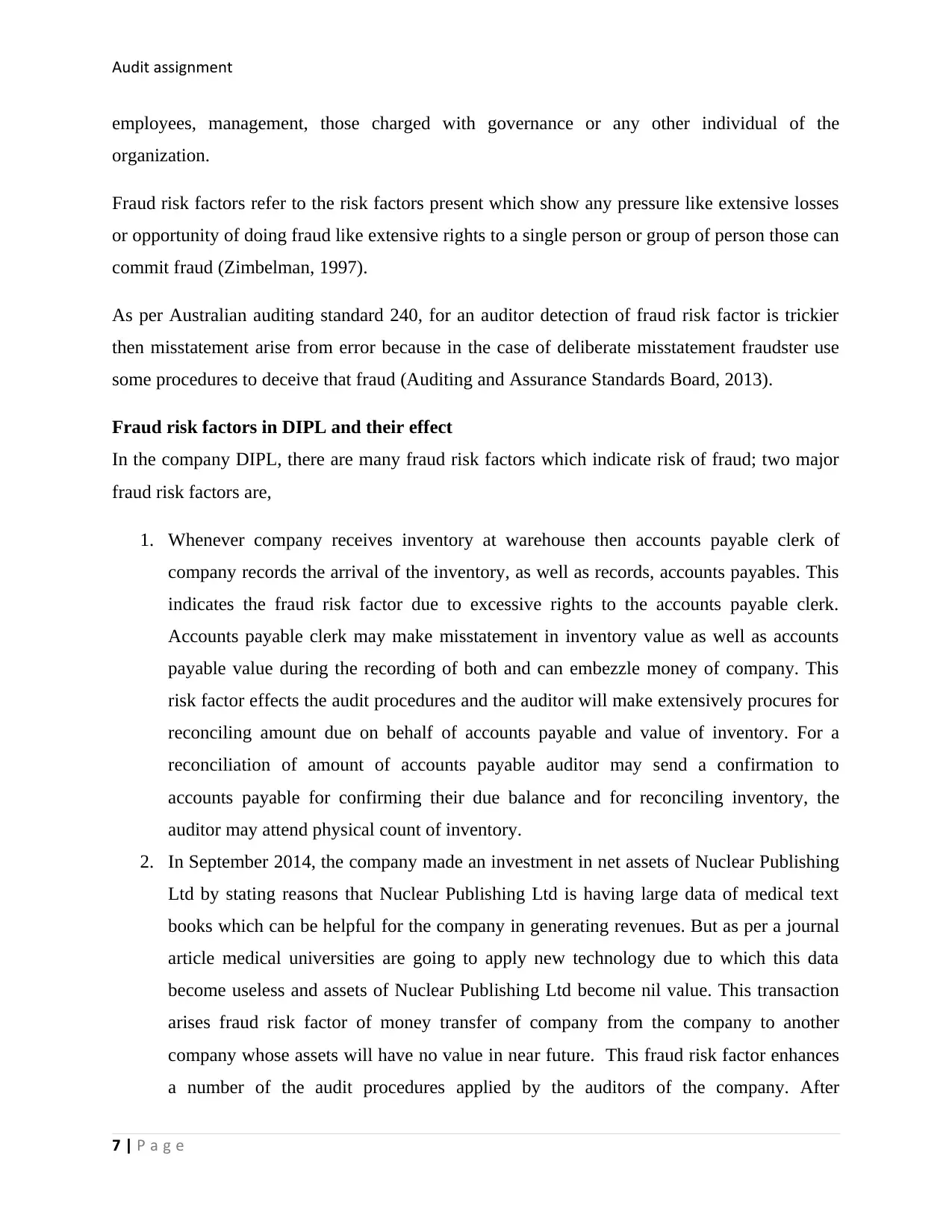
Audit assignment
employees, management, those charged with governance or any other individual of the
organization.
Fraud risk factors refer to the risk factors present which show any pressure like extensive losses
or opportunity of doing fraud like extensive rights to a single person or group of person those can
commit fraud (Zimbelman, 1997).
As per Australian auditing standard 240, for an auditor detection of fraud risk factor is trickier
then misstatement arise from error because in the case of deliberate misstatement fraudster use
some procedures to deceive that fraud (Auditing and Assurance Standards Board, 2013).
Fraud risk factors in DIPL and their effect
In the company DIPL, there are many fraud risk factors which indicate risk of fraud; two major
fraud risk factors are,
1. Whenever company receives inventory at warehouse then accounts payable clerk of
company records the arrival of the inventory, as well as records, accounts payables. This
indicates the fraud risk factor due to excessive rights to the accounts payable clerk.
Accounts payable clerk may make misstatement in inventory value as well as accounts
payable value during the recording of both and can embezzle money of company. This
risk factor effects the audit procedures and the auditor will make extensively procures for
reconciling amount due on behalf of accounts payable and value of inventory. For a
reconciliation of amount of accounts payable auditor may send a confirmation to
accounts payable for confirming their due balance and for reconciling inventory, the
auditor may attend physical count of inventory.
2. In September 2014, the company made an investment in net assets of Nuclear Publishing
Ltd by stating reasons that Nuclear Publishing Ltd is having large data of medical text
books which can be helpful for the company in generating revenues. But as per a journal
article medical universities are going to apply new technology due to which this data
become useless and assets of Nuclear Publishing Ltd become nil value. This transaction
arises fraud risk factor of money transfer of company from the company to another
company whose assets will have no value in near future. This fraud risk factor enhances
a number of the audit procedures applied by the auditors of the company. After
7 | P a g e
employees, management, those charged with governance or any other individual of the
organization.
Fraud risk factors refer to the risk factors present which show any pressure like extensive losses
or opportunity of doing fraud like extensive rights to a single person or group of person those can
commit fraud (Zimbelman, 1997).
As per Australian auditing standard 240, for an auditor detection of fraud risk factor is trickier
then misstatement arise from error because in the case of deliberate misstatement fraudster use
some procedures to deceive that fraud (Auditing and Assurance Standards Board, 2013).
Fraud risk factors in DIPL and their effect
In the company DIPL, there are many fraud risk factors which indicate risk of fraud; two major
fraud risk factors are,
1. Whenever company receives inventory at warehouse then accounts payable clerk of
company records the arrival of the inventory, as well as records, accounts payables. This
indicates the fraud risk factor due to excessive rights to the accounts payable clerk.
Accounts payable clerk may make misstatement in inventory value as well as accounts
payable value during the recording of both and can embezzle money of company. This
risk factor effects the audit procedures and the auditor will make extensively procures for
reconciling amount due on behalf of accounts payable and value of inventory. For a
reconciliation of amount of accounts payable auditor may send a confirmation to
accounts payable for confirming their due balance and for reconciling inventory, the
auditor may attend physical count of inventory.
2. In September 2014, the company made an investment in net assets of Nuclear Publishing
Ltd by stating reasons that Nuclear Publishing Ltd is having large data of medical text
books which can be helpful for the company in generating revenues. But as per a journal
article medical universities are going to apply new technology due to which this data
become useless and assets of Nuclear Publishing Ltd become nil value. This transaction
arises fraud risk factor of money transfer of company from the company to another
company whose assets will have no value in near future. This fraud risk factor enhances
a number of the audit procedures applied by the auditors of the company. After
7 | P a g e
Paraphrase This Document
Need a fresh take? Get an instant paraphrase of this document with our AI Paraphraser
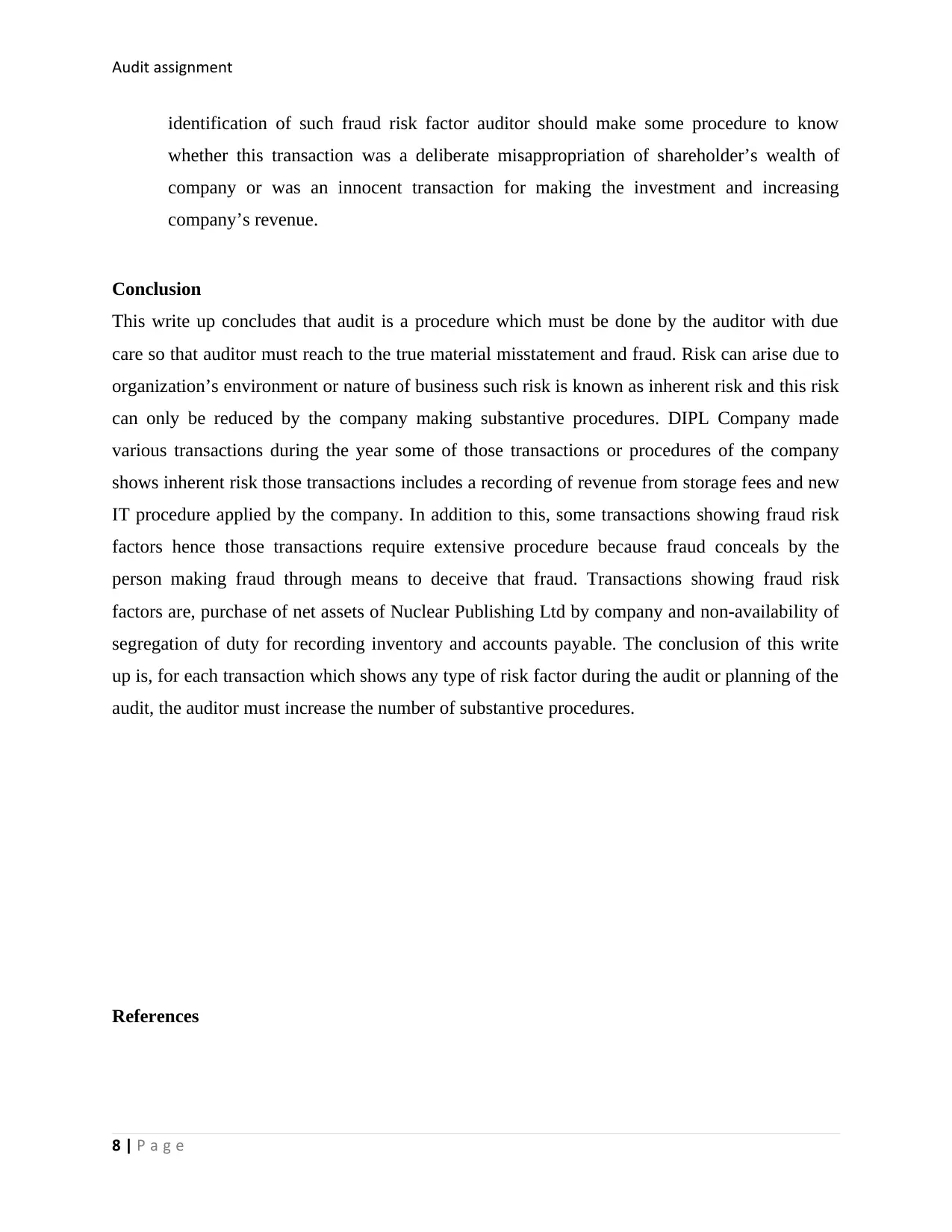
Audit assignment
identification of such fraud risk factor auditor should make some procedure to know
whether this transaction was a deliberate misappropriation of shareholder’s wealth of
company or was an innocent transaction for making the investment and increasing
company’s revenue.
Conclusion
This write up concludes that audit is a procedure which must be done by the auditor with due
care so that auditor must reach to the true material misstatement and fraud. Risk can arise due to
organization’s environment or nature of business such risk is known as inherent risk and this risk
can only be reduced by the company making substantive procedures. DIPL Company made
various transactions during the year some of those transactions or procedures of the company
shows inherent risk those transactions includes a recording of revenue from storage fees and new
IT procedure applied by the company. In addition to this, some transactions showing fraud risk
factors hence those transactions require extensive procedure because fraud conceals by the
person making fraud through means to deceive that fraud. Transactions showing fraud risk
factors are, purchase of net assets of Nuclear Publishing Ltd by company and non-availability of
segregation of duty for recording inventory and accounts payable. The conclusion of this write
up is, for each transaction which shows any type of risk factor during the audit or planning of the
audit, the auditor must increase the number of substantive procedures.
References
8 | P a g e
identification of such fraud risk factor auditor should make some procedure to know
whether this transaction was a deliberate misappropriation of shareholder’s wealth of
company or was an innocent transaction for making the investment and increasing
company’s revenue.
Conclusion
This write up concludes that audit is a procedure which must be done by the auditor with due
care so that auditor must reach to the true material misstatement and fraud. Risk can arise due to
organization’s environment or nature of business such risk is known as inherent risk and this risk
can only be reduced by the company making substantive procedures. DIPL Company made
various transactions during the year some of those transactions or procedures of the company
shows inherent risk those transactions includes a recording of revenue from storage fees and new
IT procedure applied by the company. In addition to this, some transactions showing fraud risk
factors hence those transactions require extensive procedure because fraud conceals by the
person making fraud through means to deceive that fraud. Transactions showing fraud risk
factors are, purchase of net assets of Nuclear Publishing Ltd by company and non-availability of
segregation of duty for recording inventory and accounts payable. The conclusion of this write
up is, for each transaction which shows any type of risk factor during the audit or planning of the
audit, the auditor must increase the number of substantive procedures.
References
8 | P a g e
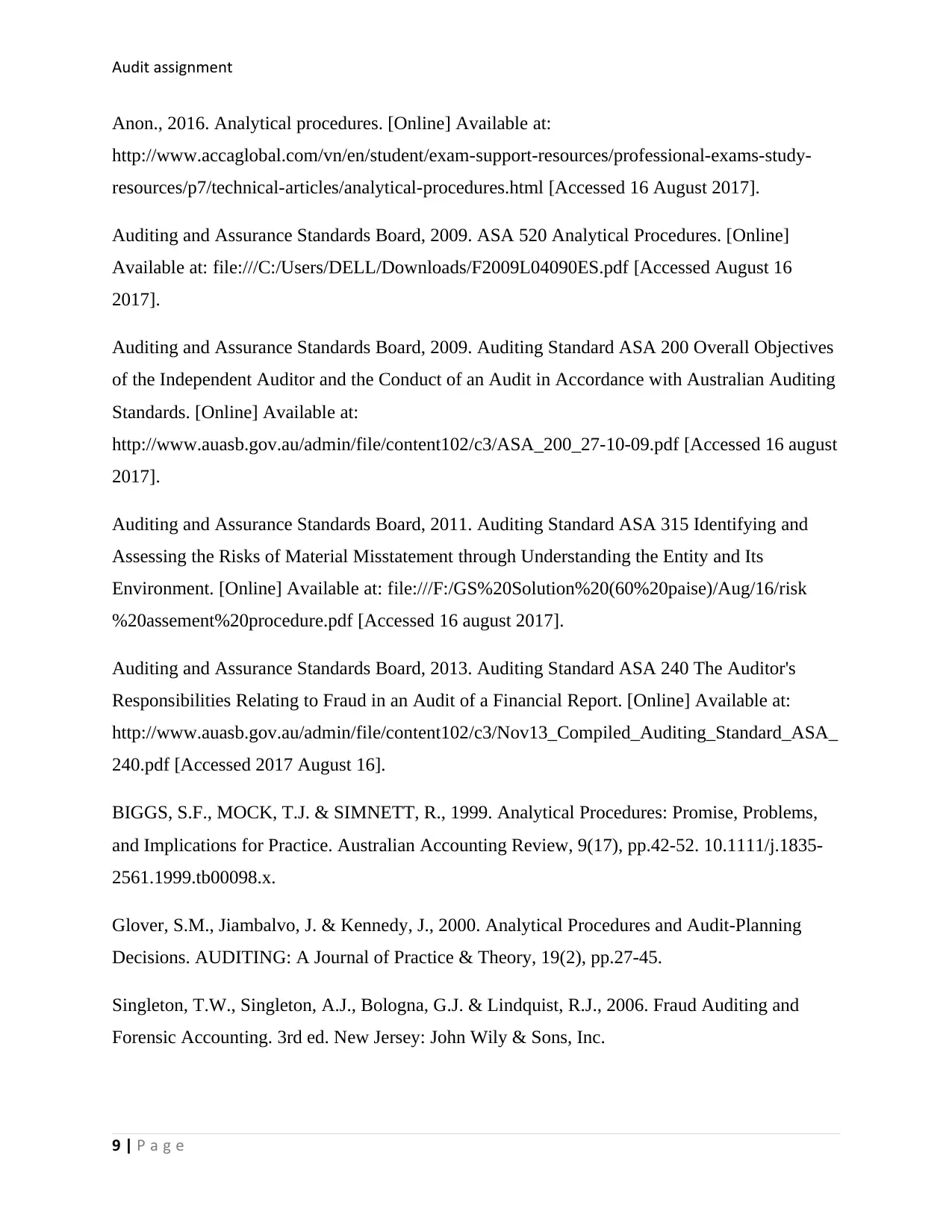
Audit assignment
Anon., 2016. Analytical procedures. [Online] Available at:
http://www.accaglobal.com/vn/en/student/exam-support-resources/professional-exams-study-
resources/p7/technical-articles/analytical-procedures.html [Accessed 16 August 2017].
Auditing and Assurance Standards Board, 2009. ASA 520 Analytical Procedures. [Online]
Available at: file:///C:/Users/DELL/Downloads/F2009L04090ES.pdf [Accessed August 16
2017].
Auditing and Assurance Standards Board, 2009. Auditing Standard ASA 200 Overall Objectives
of the Independent Auditor and the Conduct of an Audit in Accordance with Australian Auditing
Standards. [Online] Available at:
http://www.auasb.gov.au/admin/file/content102/c3/ASA_200_27-10-09.pdf [Accessed 16 august
2017].
Auditing and Assurance Standards Board, 2011. Auditing Standard ASA 315 Identifying and
Assessing the Risks of Material Misstatement through Understanding the Entity and Its
Environment. [Online] Available at: file:///F:/GS%20Solution%20(60%20paise)/Aug/16/risk
%20assement%20procedure.pdf [Accessed 16 august 2017].
Auditing and Assurance Standards Board, 2013. Auditing Standard ASA 240 The Auditor's
Responsibilities Relating to Fraud in an Audit of a Financial Report. [Online] Available at:
http://www.auasb.gov.au/admin/file/content102/c3/Nov13_Compiled_Auditing_Standard_ASA_
240.pdf [Accessed 2017 August 16].
BIGGS, S.F., MOCK, T.J. & SIMNETT, R., 1999. Analytical Procedures: Promise, Problems,
and Implications for Practice. Australian Accounting Review, 9(17), pp.42-52. 10.1111/j.1835-
2561.1999.tb00098.x.
Glover, S.M., Jiambalvo, J. & Kennedy, J., 2000. Analytical Procedures and Audit‐Planning
Decisions. AUDITING: A Journal of Practice & Theory, 19(2), pp.27-45.
Singleton, T.W., Singleton, A.J., Bologna, G.J. & Lindquist, R.J., 2006. Fraud Auditing and
Forensic Accounting. 3rd ed. New Jersey: John Wily & Sons, Inc.
9 | P a g e
Anon., 2016. Analytical procedures. [Online] Available at:
http://www.accaglobal.com/vn/en/student/exam-support-resources/professional-exams-study-
resources/p7/technical-articles/analytical-procedures.html [Accessed 16 August 2017].
Auditing and Assurance Standards Board, 2009. ASA 520 Analytical Procedures. [Online]
Available at: file:///C:/Users/DELL/Downloads/F2009L04090ES.pdf [Accessed August 16
2017].
Auditing and Assurance Standards Board, 2009. Auditing Standard ASA 200 Overall Objectives
of the Independent Auditor and the Conduct of an Audit in Accordance with Australian Auditing
Standards. [Online] Available at:
http://www.auasb.gov.au/admin/file/content102/c3/ASA_200_27-10-09.pdf [Accessed 16 august
2017].
Auditing and Assurance Standards Board, 2011. Auditing Standard ASA 315 Identifying and
Assessing the Risks of Material Misstatement through Understanding the Entity and Its
Environment. [Online] Available at: file:///F:/GS%20Solution%20(60%20paise)/Aug/16/risk
%20assement%20procedure.pdf [Accessed 16 august 2017].
Auditing and Assurance Standards Board, 2013. Auditing Standard ASA 240 The Auditor's
Responsibilities Relating to Fraud in an Audit of a Financial Report. [Online] Available at:
http://www.auasb.gov.au/admin/file/content102/c3/Nov13_Compiled_Auditing_Standard_ASA_
240.pdf [Accessed 2017 August 16].
BIGGS, S.F., MOCK, T.J. & SIMNETT, R., 1999. Analytical Procedures: Promise, Problems,
and Implications for Practice. Australian Accounting Review, 9(17), pp.42-52. 10.1111/j.1835-
2561.1999.tb00098.x.
Glover, S.M., Jiambalvo, J. & Kennedy, J., 2000. Analytical Procedures and Audit‐Planning
Decisions. AUDITING: A Journal of Practice & Theory, 19(2), pp.27-45.
Singleton, T.W., Singleton, A.J., Bologna, G.J. & Lindquist, R.J., 2006. Fraud Auditing and
Forensic Accounting. 3rd ed. New Jersey: John Wily & Sons, Inc.
9 | P a g e
⊘ This is a preview!⊘
Do you want full access?
Subscribe today to unlock all pages.

Trusted by 1+ million students worldwide
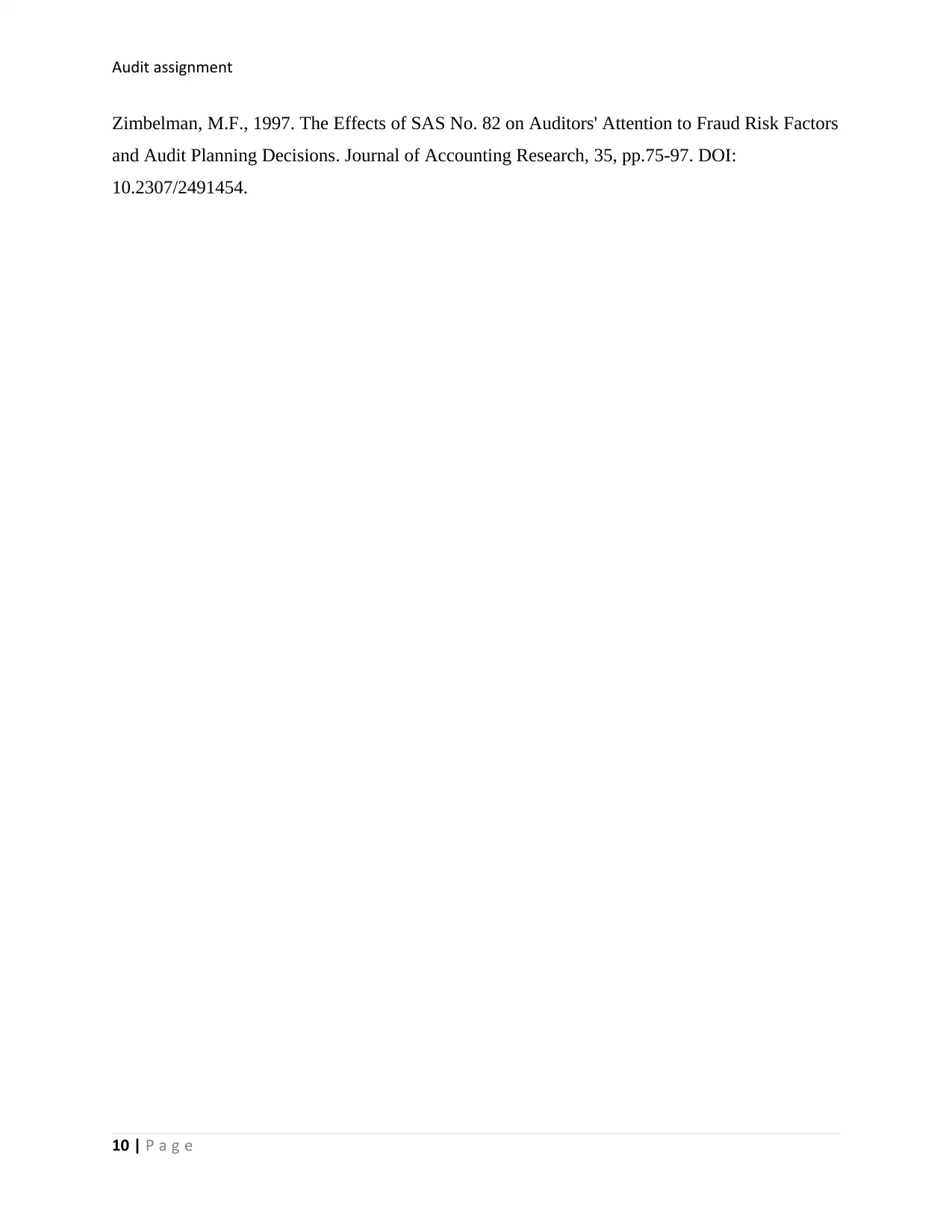
Audit assignment
Zimbelman, M.F., 1997. The Effects of SAS No. 82 on Auditors' Attention to Fraud Risk Factors
and Audit Planning Decisions. Journal of Accounting Research, 35, pp.75-97. DOI:
10.2307/2491454.
10 | P a g e
Zimbelman, M.F., 1997. The Effects of SAS No. 82 on Auditors' Attention to Fraud Risk Factors
and Audit Planning Decisions. Journal of Accounting Research, 35, pp.75-97. DOI:
10.2307/2491454.
10 | P a g e
1 out of 10
Related Documents
Your All-in-One AI-Powered Toolkit for Academic Success.
+13062052269
info@desklib.com
Available 24*7 on WhatsApp / Email
![[object Object]](/_next/static/media/star-bottom.7253800d.svg)
Unlock your academic potential
Copyright © 2020–2025 A2Z Services. All Rights Reserved. Developed and managed by ZUCOL.





